New Model for Non-Spherical Particles Drag Coefficients in Non-Newtonian Fluid
Abstract
1. Introduction
2. Research Methods
2.1. Testing Materials and Fluid Rheology
2.2. Measurement of Particle Shape Factor
2.3. Experimental Equipment and Procedures
3. Results and Discussion
3.1. Drag Coefficient of SPs
3.2. Drag Coefficient of NSPs
4. Conclusions
Author Contributions
Funding
Conflicts of Interest
References
- Awad, A.M.; Hussein, I.A.; Nasser, M.S.; Karami, H.; Ahmed, R. CFD modeling of particle settling in drilling fluids: Impact of fluid rheology and particle characteristics. J. Pet. Sci. Eng. 2021, 199, 108326. [Google Scholar] [CrossRef]
- Qu, J.; Yan, T.; Sun, X.; Li, Z.; Li, W. Decaying swirl flow and particle behavior through the hole cleaning device for horizontal drilling of fossil fuel. Energies 2019, 12, 336. [Google Scholar] [CrossRef]
- Zhang, G.; Gutierrez, M.; Chao, K. Hydrodynamic and mechanical behavior of multi-particle confined between two parallel plates. Adv. Powder Technol. 2019, 30, 439–450. [Google Scholar] [CrossRef]
- Stokes, G.G. On the effect of the internal friction of fluids in the motion of pendulums. Trans. Cambridge Philos. Soc. 1851, 9, 8–106. [Google Scholar]
- Abraham, F.F. Functional dependence of drag coefficient of a sphere on Reynolds number. Phys. Fluids 1970, 13, 2194–2195. [Google Scholar] [CrossRef]
- Clift, R.; Gauvin, W.H. Motion of entrained particles in gas streams. Can. J. Chem. Eng. 1971, 49, 439–448. [Google Scholar] [CrossRef]
- Brown, P.P.; Lawler, D.F. Sphere drag and settling velocity revisited. J. Environ. Eng. 2003, 129, 222–231. [Google Scholar] [CrossRef]
- Terfous, A.; Hazzab, A.; Ghenaim, A. Predicting the drag coefficient and settling velocity of spherical particles. Powder Technol. 2013, 239, 12–20. [Google Scholar] [CrossRef]
- Agwu, O.E.; Akpabio, J.U.; Alabi, S.B.; Dosunmu, A. Settling velocity of drill cuttings in drilling fluids: A review of experimental, numerical simulations and artificial intelligence studies. Powder Technol. 2018, 339, 728–746. [Google Scholar] [CrossRef]
- Goossens, W.R.A. Review of the empirical correlations for the drag coefficient of rigid spheres. Powder Technol. 2019, 352, 350–359. [Google Scholar] [CrossRef]
- Yao, S.; Chang, C.; Hai, K.; Huang, H.; Li, H. A review of experimental studies on the proppant settling in hydraulic fractures. J. Pet. Sci. Eng. 2022, 208, 109211. [Google Scholar] [CrossRef]
- Chhabra, R.P. Motion of spheres in power law (viscoinelastic) fluids at intermediate Reynolds numbers: A unified approach. Chem. Eng. Process. Process Intensif. 1990, 28, 89–94. [Google Scholar] [CrossRef]
- Lali, A.M.; Khare, A.S.; Joshi, J.B.; Nigam, K.D.P. Behaviour of solid particles in viscous non-Newtonian solutions: Settling velocity, wall effects and bed expansion in solid-liquid fluidized beds. Powder Technol. 1989, 57, 39–50. [Google Scholar] [CrossRef]
- Kelessidis, V.C. Terminal velocity of solid spheres falling in Newtonian and non-Newtonian liquids. Tech. Chron. Sci. J. TCG 2003, 5, 43–54. [Google Scholar]
- Shah, S.N.; El Fadili, Y.; Chhabra, R.P. New model for single spherical particle settling velocity in power law (visco-inelastic) fluids. Int. J. Multiph. Flow 2007, 33, 51–66. [Google Scholar] [CrossRef]
- Peden, J.M.; Luo, Y. Settling velocity of variously shaped particles in drilling and fracturing fluids. SPE Drill. Eng. 1987, 2, 337–343. [Google Scholar] [CrossRef]
- Kelessidis, V.C.; Mpandelis, G. Measurements and prediction of terminal velocity of solid spheres falling through stagnant pseudoplastic liquids. Powder Technol. 2004, 147, 117–125. [Google Scholar] [CrossRef]
- Turton, R.; Levenspiel, O. A short note on the drag correlation for spheres. Powder Technol. 1986, 47, 83–86. [Google Scholar] [CrossRef]
- Haider, A.; Levenspiel, O. Drag coefficient and terminal velocity of spherical and nonspherical particles. Powder Technol. 1989, 58, 63–70. [Google Scholar] [CrossRef]
- Cheng, N.S. Comparison of formulas for drag coefficient and settling velocity of spherical particles. Powder Technol. 2009, 189, 395–398. [Google Scholar] [CrossRef]
- Song, X.; Xu, Z.; Li, G.; Pang, Z.; Zhu, Z. A new model for predicting drag coefficient and settling velocity of spherical and non-spherical particle in Newtonian fluid. Powder Technol. 2017, 321, 242–250. [Google Scholar] [CrossRef]
- Okesanya, T.; Abdukarimov, A.; Kuru, E. Generalized models for predicting the drag coefficient and settling velocity of rigid spheres in viscoelastic and viscoinelastic power-law fluids. J. Pet. Sci. Eng. 2020, 191, 107077. [Google Scholar] [CrossRef]
- Khan, A.R.; Richardson, J.F. The resistance to motion of a solid sphere in a fluid. Chem. Eng. Commun. 1987, 62, 135–150. [Google Scholar] [CrossRef]
- Zhang, G.; Li, M.; Geng, K.; Han, R.; Xie, M.; Liao, K. New integrated model of the settling velocity of proppants falling in viscoelastic slick-water fracturing fluids. J. Nat. Gas Sci. Eng. 2016, 33, 518–526. [Google Scholar] [CrossRef]
- Padhy, S.; Rodriguez, M.; Shaqfeh, E.; Iaccarino, G.; Morris, J.; Tonmukayakul, N. The effect of shear thinning and walls on the sedimentation of a sphere in an elastic fluid under orthogonal shear. J. Non-Newton. Fluid Mech. 2013, 201, 120–129. [Google Scholar] [CrossRef]
- Williams, G.P. Particle roundness and surface texture effects on fall velocity. J. Sediment. Petrol. 1997, 36, 255–259. [Google Scholar] [CrossRef]
- Wadell, H. The coefficient of resistance as a function of Reynolds number for solids of various shapes. J. Frankl. Inst. 1934, 217, 459–490. [Google Scholar] [CrossRef]
- Tran-Cong, S.; Gay, M.; Michaelides, E.E. Drag coefficients of irregularly shaped particles. Powder Technol. 2004, 139, 21–32. [Google Scholar] [CrossRef]
- Corey, A.T. Influence of the Shape on the Fall Velocity of Sand Grains. Ph.D. Thesis, Colorado State University, Fort Collins, CO, USA, 1949. [Google Scholar]
- Bouwman, A.M.; Bosma, J.C.; Vonk, P.; Wesselingh, J.H.A.; Frijlink, H.W. Which shape factor (s) best describe granules? Powder Technol. 2004, 146, 66–72. [Google Scholar] [CrossRef]
- Hölzer, A.; Sommerfeld, M. New simple correlation formula for the drag coefficient of non-spherical particles. Powder Technol. 2008, 184, 361–365. [Google Scholar] [CrossRef]
- Wang, Y.; Zhou, L.; Wu, Y.; Yang, Q. New simple correlation formula for the drag coefficient of calcareous sand particles of highly irregular shape. Powder Technol. 2018, 326, 379–392. [Google Scholar] [CrossRef]
- Chien, S.F. Settling velocity of irregularly shaped particles. SPE Drill. Complet. 1994, 9, 281–289. [Google Scholar] [CrossRef]
- Dioguardi, F.; Mele, D. A new shape dependent drag correlation formula for non-spherical rough particles. Exp. Results. Powder Technol. 2015, 277, 222–230. [Google Scholar] [CrossRef]
- Xu, Z.; Song, X.; Li, G.; Pang, Z.; Zhu, Z. Settling behavior of non-spherical particles in power-law fluids: Experimental study and model development. Particuology 2019, 46, 30–39. [Google Scholar] [CrossRef]
- Rushd, S.; Hafsa, N.; Al-Faiad, M.; Arifuzzaman, M. Modeling the settling velocity of a sphere in Newtonian and non-Newtonian fluids with machine-learning algorithms. Symmetry 2021, 13, 71. [Google Scholar] [CrossRef]
- Barati, R.; Neyshabouri, S.A.A.S.; Ahmadi, G. Development of empirical models with high accuracy for estimation of drag coefficient of flow around a smooth sphere: An evolutionary approach. Powder Technol. 2014, 257, 11–19. [Google Scholar]
- Akanni, O.; Fu, C.; Guo, B. Drag Coefficients of Irregularly Shaped Particles in Newtonian Fluids. Sustainability 2021, 13, 7517. [Google Scholar] [CrossRef]
- Gavrilov, A.A.; Finnikov, K.A.; Podryabinkin, E.V. Modeling of steady Herschel–Bulkley fluid flow over a sphere. J. Eng. Thermophys. 2017, 26, 197–215. [Google Scholar] [CrossRef]
- Zhou, C.; Su, J.; Chen, H.; Shi, Z. Terminal velocity and drag coefficient models for disc-shaped particles based on the imaging experiment. Powder Technol. 2022, 398, 117062. [Google Scholar] [CrossRef]
- Okesanya, T.; Kuru, E.; Sun, Y. A New Generalized Model for Predicting the Drag Coefficient and the Settling Velocity of Rigid Spheres in Viscoplastic Fluids. SPE J. 2020, 25, 3217–3235. [Google Scholar] [CrossRef]
- Yan, T.; Qu, J.Y.; Sun, X.F.; Li, W.; Chen, Y.; Hu, Q.B. A novel predictive model of drag coefficient and settling velocity of drill cuttings in non-Newtonian drilling fluids. Pet. Sci. 2021, 18, 1729–1738. [Google Scholar] [CrossRef]

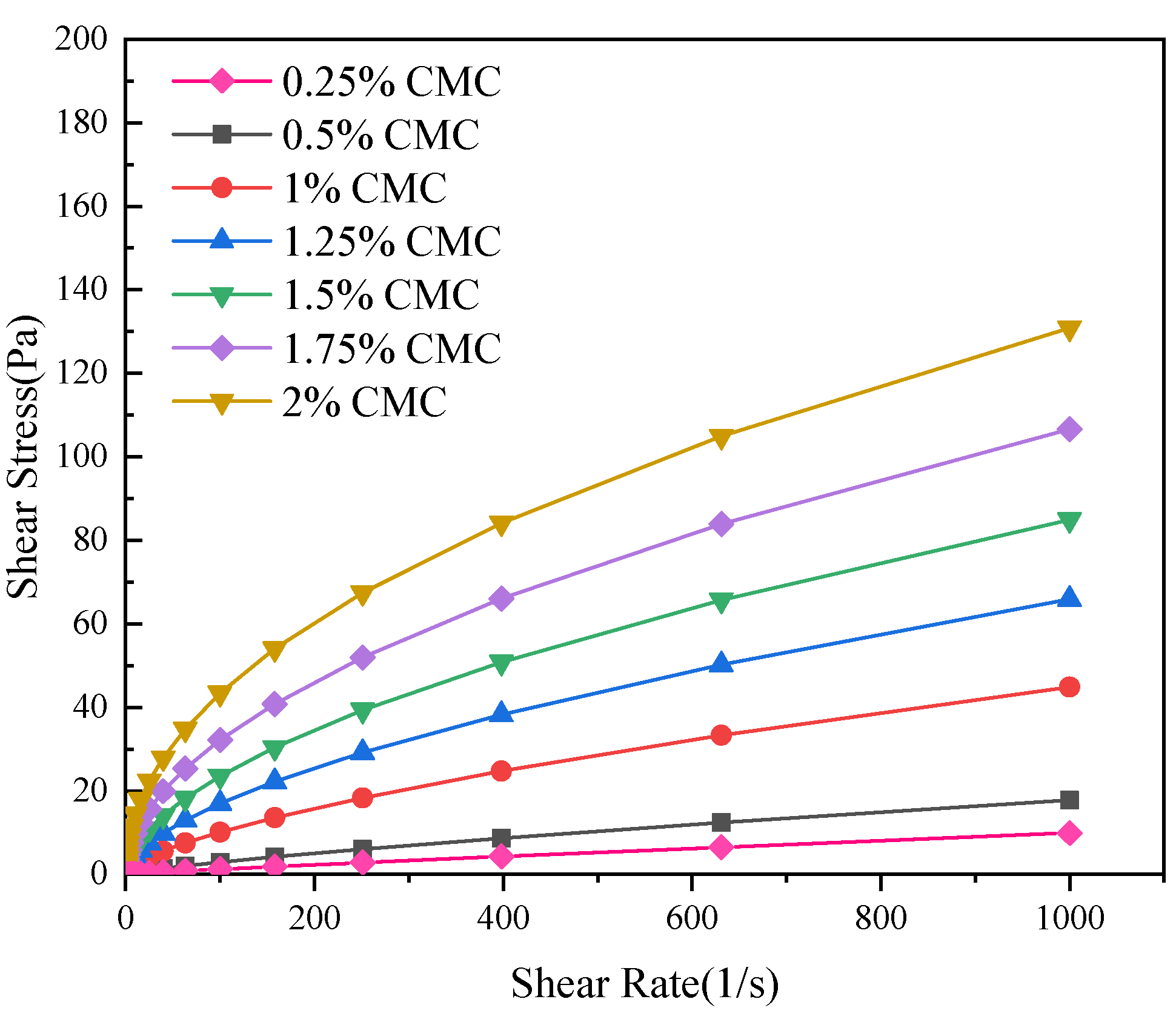
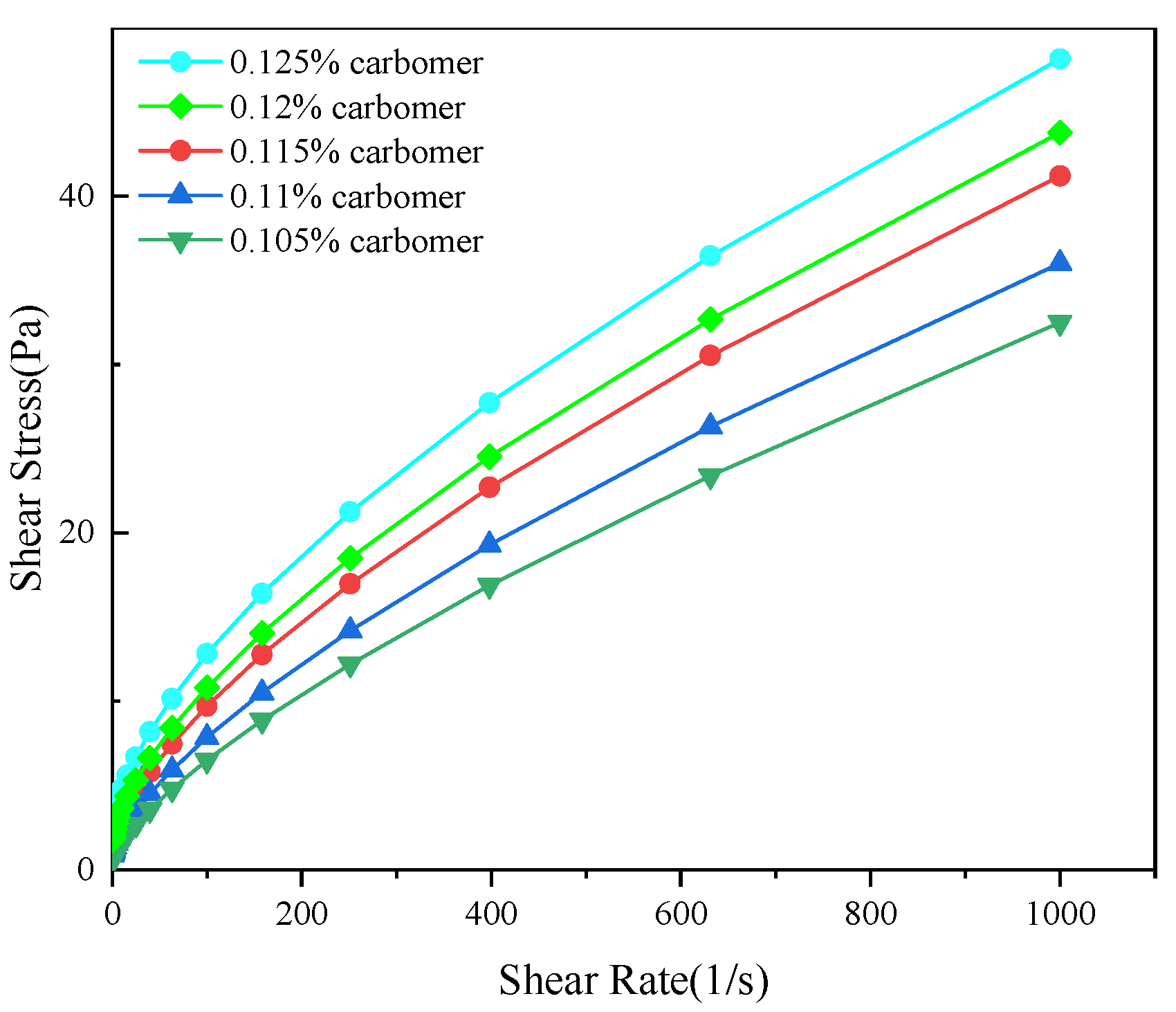
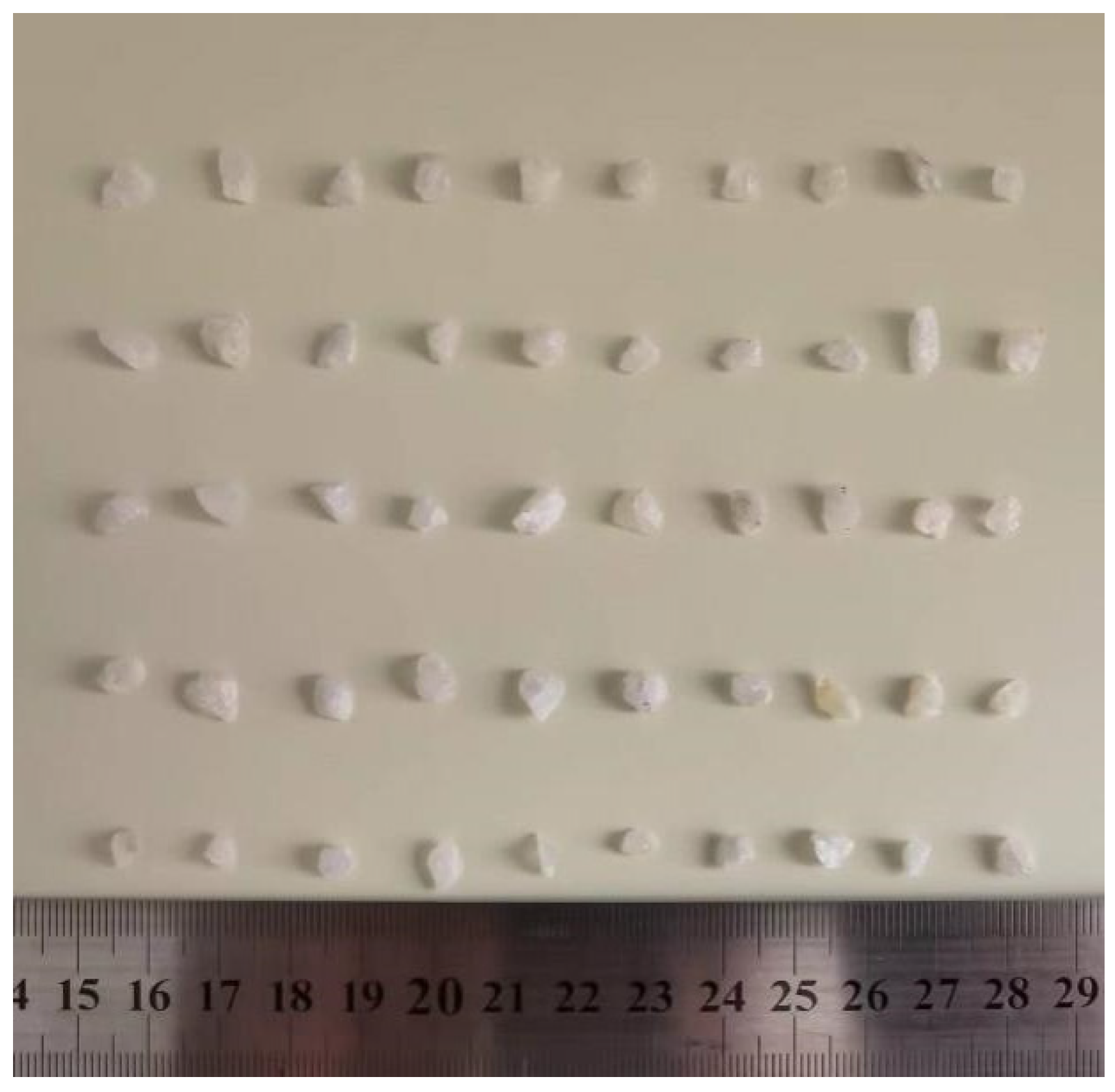
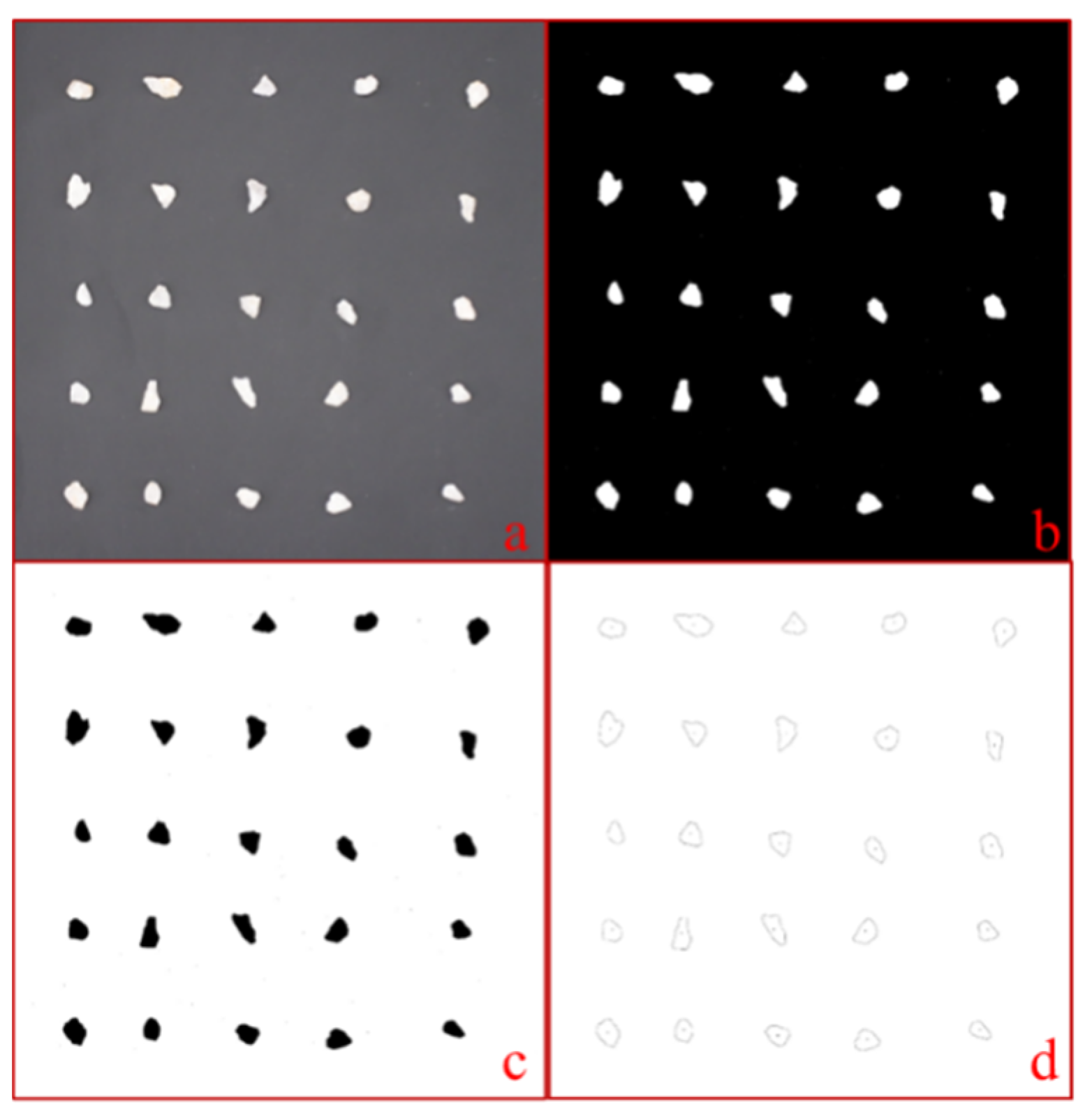
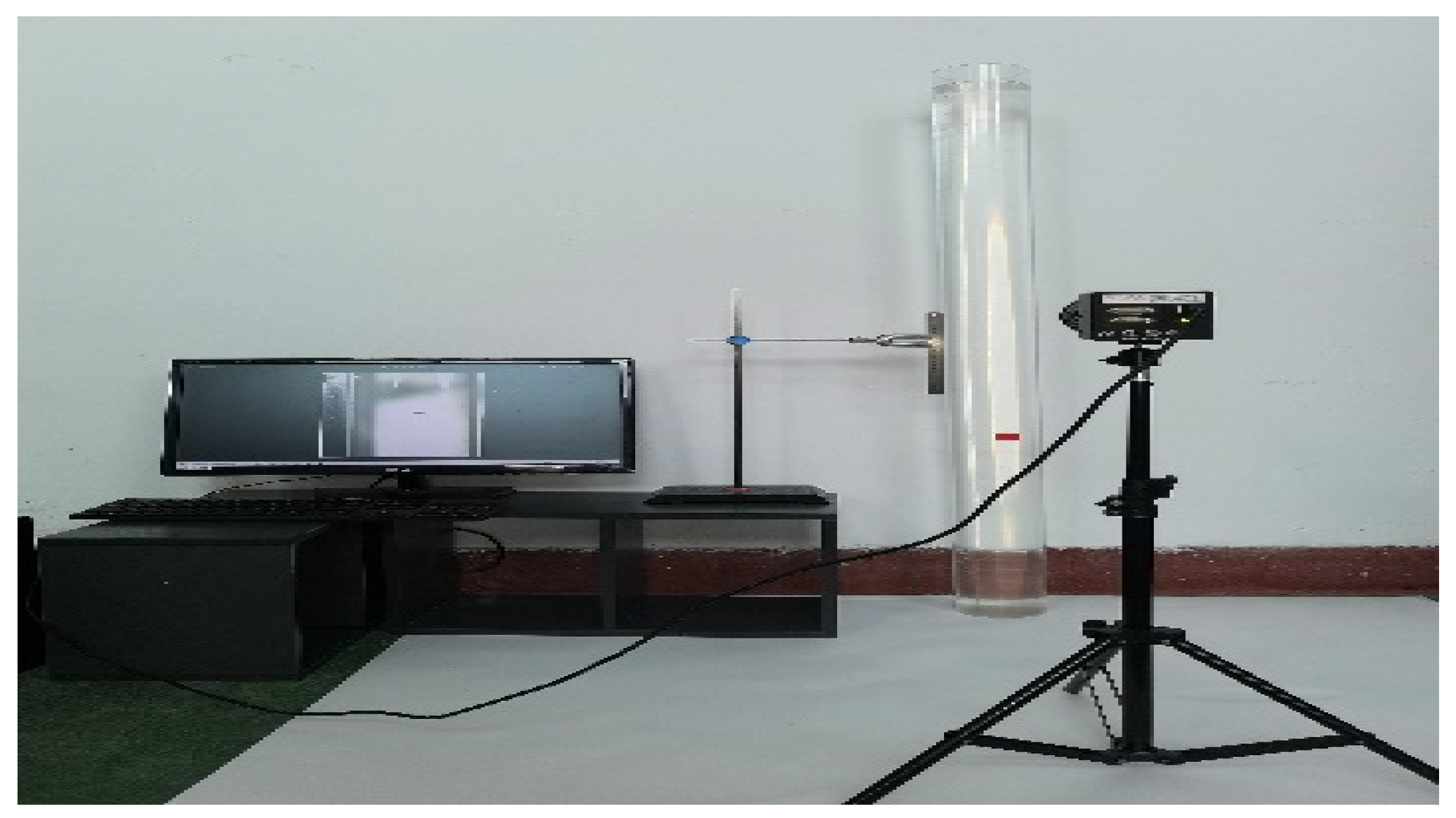
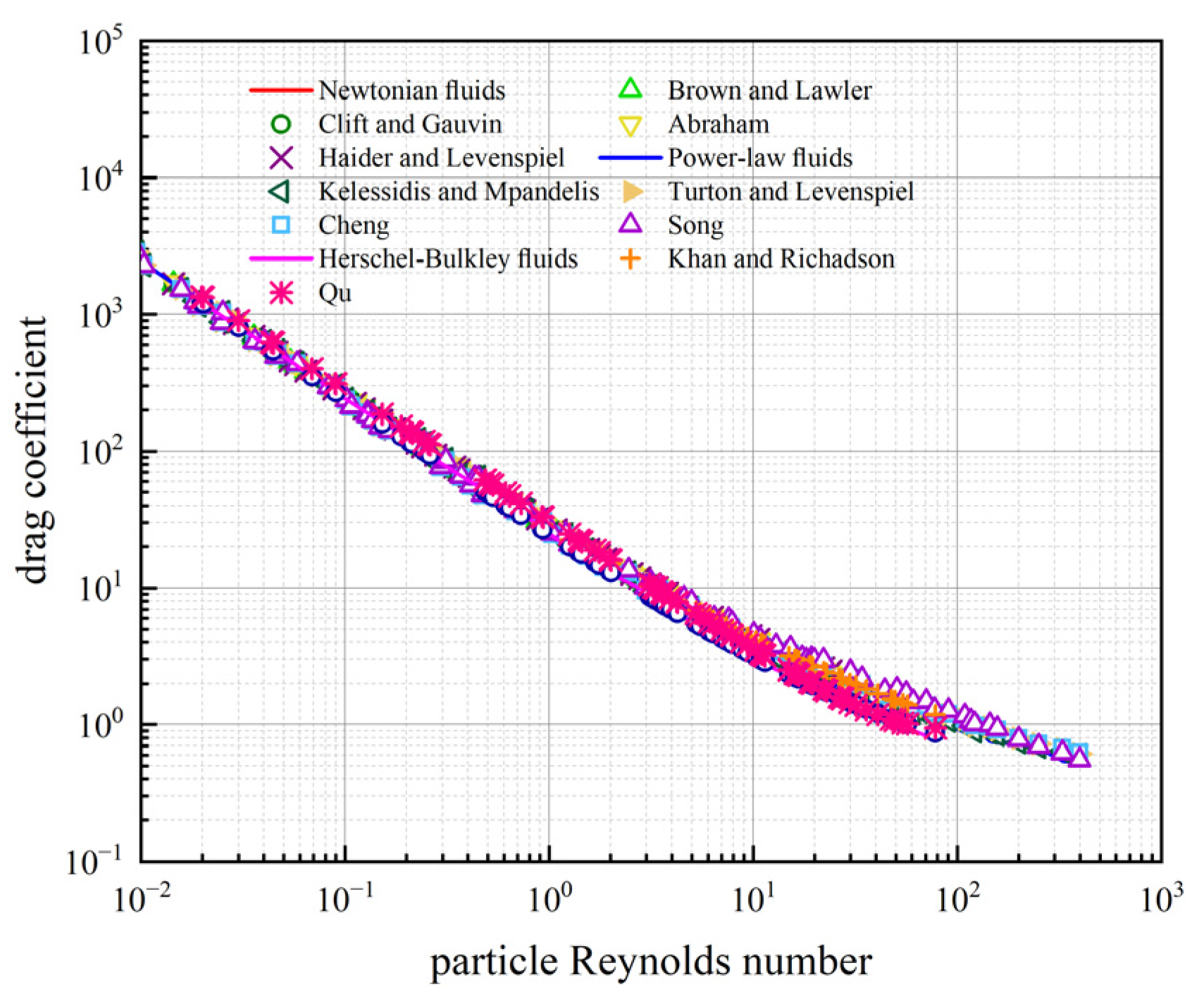
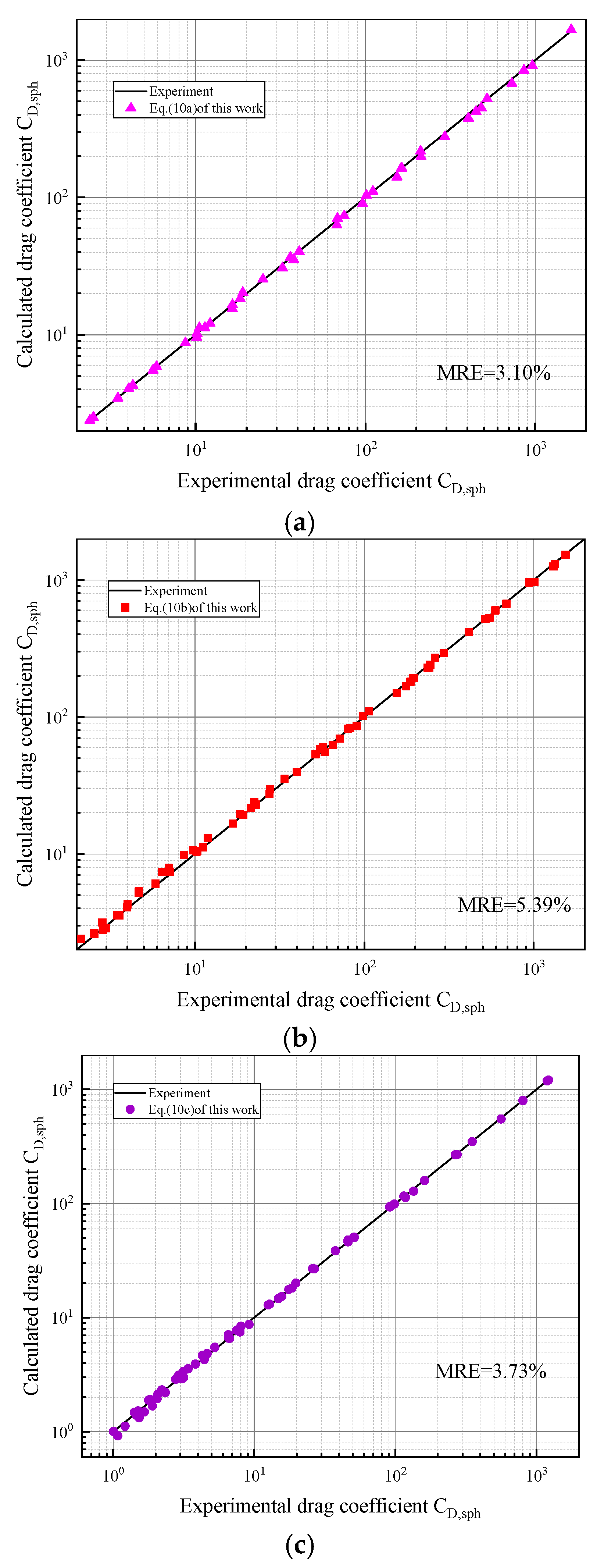

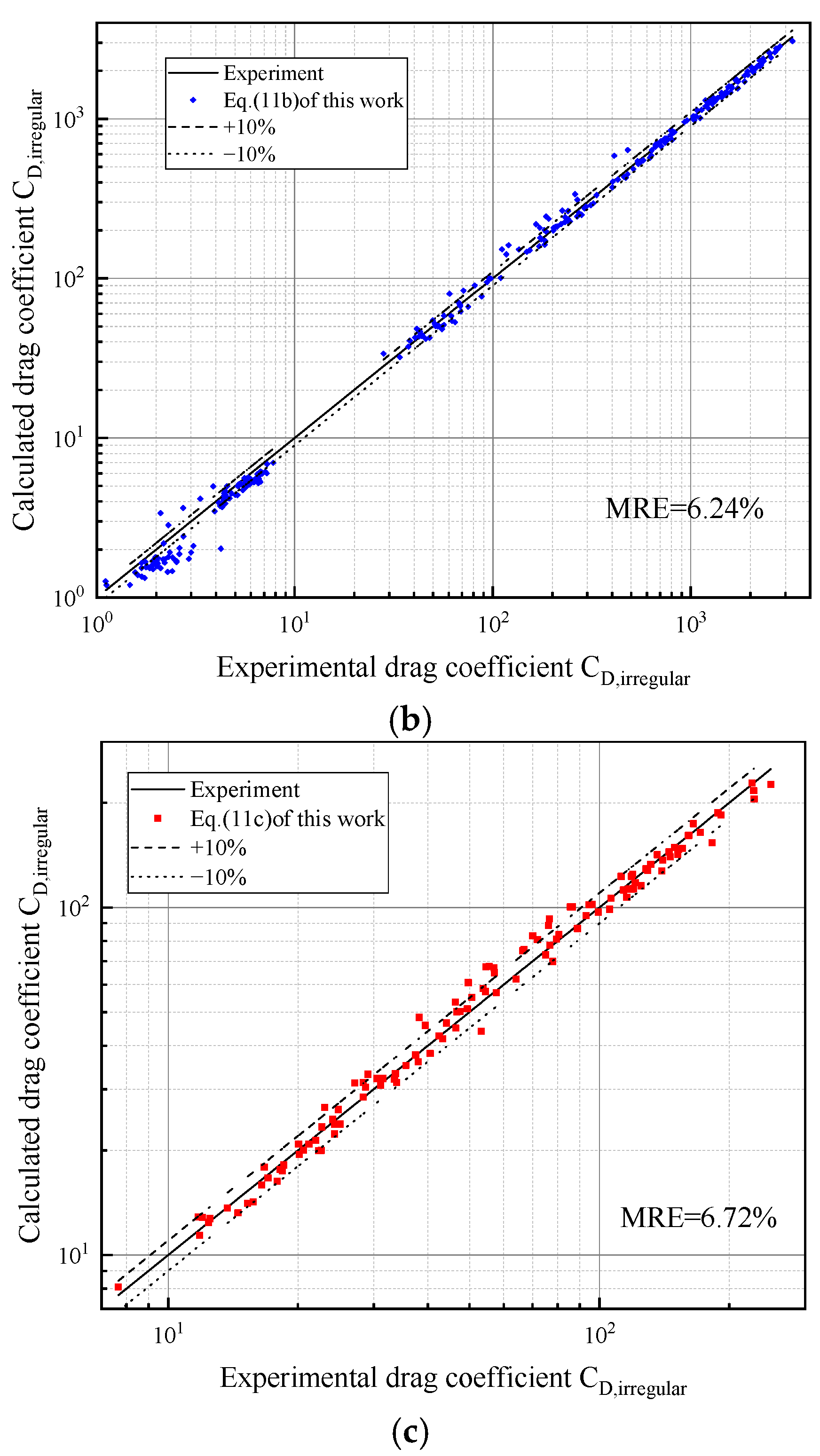
| Rheological Models | Equation |
|---|---|
| Newton | |
| Power law | |
| Herschel-Bulkley |
| Test Fluids | Temperature, (°C) | Density, kg/m3 | Rheological Parameters | ||
|---|---|---|---|---|---|
| τ0, Pa | K, Pa·sn | n | |||
| 80 wt % glycerol | 24.3 | 1210 | 0 | 0.04562 | 1 |
| 90 wt % glycerol | 22.1 | 1220 | 0 | 0.17059 | 1 |
| 95 wt % glycerol | 24.5 | 1240 | 0 | 0.34144 | 1 |
| 100 wt % glycerol | 22.9 | 1250 | 0 | 0.88462 | 1 |
| 0.25 wt % CMC | 20.3 | 1001.5 | 0 | 0.0199 | 0.8986 |
| 0.5 wt % CMC | 20.2 | 1001.5 | 0 | 0.0815 | 0.7797 |
| 1 wt % CMC | 20.9 | 1003 | 0 | 0.5144 | 0.6470 |
| 1.25 wt % CMC | 21.3 | 1003.2 | 0 | 1.1256 | 0.5891 |
| 1.5 wt % CMC | 22.1 | 1004 | 0 | 1.8128 | 0.5569 |
| 1.75 wt % CMC | 21.4 | 1004.5 | 0 | 2.9310 | 0.5203 |
| 2 wt % CMC | 20.0 | 1006 | 0 | 4.7803 | 0.4791 |
| 0.105 wt % carbomer | 23.9 | 1000 | 0.5041 | 0.2111 | 0.7268 |
| 0.11 wt % carbomer | 24.3 | 1000 | 0.8363 | 0.2803 | 0.6995 |
| 0.115 wt % carbomer | 23.9 | 1000 | 1.2990 | 0.3757 | 0.6754 |
| 0.12 wt % carbomer | 23.6 | 1000 | 1.6841 | 0.4304 | 0.6634 |
| 0.125 wt % carbomer | 23.6 | 1000 | 2.4108 | 0.5432 | 0.6418 |
| Reference | CD-ReN Empirical Correlations |
|---|---|
| Abraham [5] | |
| Clift and Gauvin [6] | |
| Brown and Lawler [7] | |
| Kelessidis and Mpandelis [17] | |
| Turton and Levenspiel [18] | |
| Haider and Levenspiel [19] | |
| Cheng [20] | |
| Song [21] | |
| Khan and Richadson [23] | |
| Qu [42] |
| Fluid Type | Correlation | Prediction Error (%) | ||
|---|---|---|---|---|
| MRE | RMSLE | SSE | ||
| Newtonian fluid | Brown and Lawler | 3.41 | 4.10 | 0.14 |
| Clift and Gauvin | 3.30 | 0.30 | 0.14 | |
| Abraham | 4.89 | 5.92 | 0.15 | |
| Haider and Levenspiel | 4.04 | 4.48 | 0.13 | |
| Power-law fluid | Kelessidis and Mpandelis | 9.62 | 10.74 | 1.21 |
| Turton and Levenspiel | 10.61 | 11.97 | 1.21 | |
| Cheng | 10.78 | 12.41 | 1.18 | |
| Song | 12.57 | 14.48 | 1.18 | |
| Herschel-Bulkley fluid | Khan and Richadson | 20.57 | 21.95 | 0.02 |
| Qu | 15.66 | 15.93 | 1.33 | |
Publisher’s Note: MDPI stays neutral with regard to jurisdictional claims in published maps and institutional affiliations. |
© 2022 by the authors. Licensee MDPI, Basel, Switzerland. This article is an open access article distributed under the terms and conditions of the Creative Commons Attribution (CC BY) license (https://creativecommons.org/licenses/by/4.0/).
Share and Cite
Liu, J.; Hou, Z.; Xu, G.; Yan, L. New Model for Non-Spherical Particles Drag Coefficients in Non-Newtonian Fluid. Processes 2022, 10, 1990. https://doi.org/10.3390/pr10101990
Liu J, Hou Z, Xu G, Yan L. New Model for Non-Spherical Particles Drag Coefficients in Non-Newtonian Fluid. Processes. 2022; 10(10):1990. https://doi.org/10.3390/pr10101990
Chicago/Turabian StyleLiu, Jiankun, Zhaokai Hou, Guoqing Xu, and Lipeng Yan. 2022. "New Model for Non-Spherical Particles Drag Coefficients in Non-Newtonian Fluid" Processes 10, no. 10: 1990. https://doi.org/10.3390/pr10101990
APA StyleLiu, J., Hou, Z., Xu, G., & Yan, L. (2022). New Model for Non-Spherical Particles Drag Coefficients in Non-Newtonian Fluid. Processes, 10(10), 1990. https://doi.org/10.3390/pr10101990






